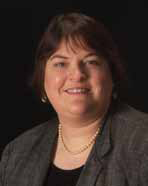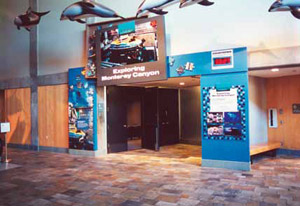Master Interpreter

Lisa Thorburn Serves As A Translator Between Clients And Engineers At Thorburn Associates
by Kirsten Nelson
QUICK BIO
NAME: Lisa Thorburn
TITLE: President
COMPANY: Thorburn Associates
OVERTIME: Thorburn’s role as a master interpreter is vital in understanding what the client wants. As Thorburn Associates continues to expand, she is developing documentation and procedures for others in the company to join her as master interpreters.

SCN: Where did the inspiration for creating Thorburn Associates come from?
Lisa Thorburn: I grew up in a family that encouraged me to work hard in order to achieve my goals. My father owned his own engineering and surveying firm and my mother had a college degree in mathematics, which was virtually unheard of at the time.
When I went to Michigan Tech, I had already decided that I wanted to be an engineer, but wasn’t sure exactly what direction I wanted to take. On my first day at college I met my future husband and business partner Steve Thorburn through some mutual friends. He got heavily involved in the technical aspect of theater and electrical engineering, and I ended up procuring a career in computer science and technical communications.
A daily selection of the top stories for AV integrators, resellers and consultants. Sign up below.
After college, I worked with several large Silicon Valley companies as a systems analyst, doing Structured English programming. Steve began work as an acoustical engineer and quickly got involved in the experience industry, working on projects for Disney, Dolby Labs, and a host of more typical projects and clients.
As the typical entrepreneurial story goes, we started Thorburn Associates (TA) in our garage in California in 1992, with plans to grow the company. Steve focused on the acoustical and electrical engineering details while I used my technical background and communication skills to address our clients’ needs, which we still do at TA today.
SCN: How has the company grown, along with the industry?
LT: By 1994 we were ready to expand to bigger offices and bring on more employees. In 1998 we opened an office in North Carolina, which helped to open up new markets to us. Initially, our projects were often in the entertainment field. But as that industry has matured, it has influenced other industries to take acoustical and audiovisual components into account during the design process, and we have adapted to serve a variety of markets.
Today, we see a lot of growth in the civic and educational sectors, and even military projects are on the rise. The interesting thing about working in the technology field is it is always changing, which means you have to constantly re-align your business. In recent years, the convergence of different devices all being controlled over IP has really affected our industry. It is causing the various technologies that make up AV to really blend into one discipline. Our clients are realizing this too, as they are increasingly coming to us to be a one-stop shop for all their lighting, audiovisual, security, structured wiring, and acoustical needs.

A career-defining moment occurred during Lisa Thorburn’s work at the Monterey Bay Aquarium, a project that was “HD” before HD was out in the mass public. SCN: How have you, personally and professionally, learned to adapt to the changing AV market?
LT: I think there are two secrets to dealing with any sort of rapidly changing environment. First, you need to be able to have a laser-tight focus and pay attention to details. Secondly, you have to continually educate yourself.
I really believe the best way to learn something is to teach it to someone else, so I am actively involved in a variety of educational projects. For the past seven years, I have taught T’ai Chi Chih, a meditative form of T’ai Chi. It has taught me how to center myself and bring focus to what is important. It has also helped me be more comfortable teaching in other arenas.
In July I presented a white paper on Doing Business in China at the annual Society for Marketing Professional Services conference in Boston.
Each year at InfoComm, Steve and I, along with our team, present several hours of educational sessions on a variety of topics. I also am involved in a variety of Lunch and Learn presentations to clients, which I think are crucial for getting immediate feedback from people in the field and working with the changing design needs on a daily basis.
On the corporate level, TA is committed to advancing education efforts, but we are also always looking for ways we can meet more of our clients’ needs. Most recently, we merged with Gallegos Lighting in order to be able to add full lighting design services to our portfolio. Moving forward, as we see opportunities for expansion into other fields that will benefit our clients, we will pursue them.
SCN: How has your role in the company evolved?
LT: I have always functioned on our clients’ behalf as a sort of translator between them and the engineers. I start by interviewing clients and listening to them to gain an understanding of what it is they want. I then interpret the technical information and create a needs analysis or programming document that anyone can understand.
Our clients are experts at their business, and they come to us because we are experts at ours. We can’t expect them to know everything about our technology, but we do have to create solutions for them in a way that they can understand.
SCN: How would you complete the following statements? Project management in a highly technical and creative field requires...
three things: an impeccable attention to detail, an ability to really listen to the client, and a focus on providing the right technical information to the right people.
The most defining moment/project in my career was...
when I was on site at the Monterey Bay Aquarium during final test and adjustments on the new deep-sea linker auditorium. This project was “HD” before HD was out in the mass public, and included live satellite feeds from the research ships that were controlling an unmanned submersible in the waters of Monterey Canyon. While we had the satellite feed up, we saw this “critter” it was long like a ribbon and it had wrapped itself around part of the submersible like a ribbon around a car antenna. That night at the grand opening (strange how that happens—test and adjust within hours of using the system with the public for the first time, but I digress) we found out that the multicell siphonifera had never been seen by “man” before and the four of us in the control room watching the uplink and the folks on the boat were the first to see it. While not a personally defining moment, it is one of my best memories and I remember thinking to myself: How cool is that! Our engineering will let others see what only a few have seen before, and in real time!
